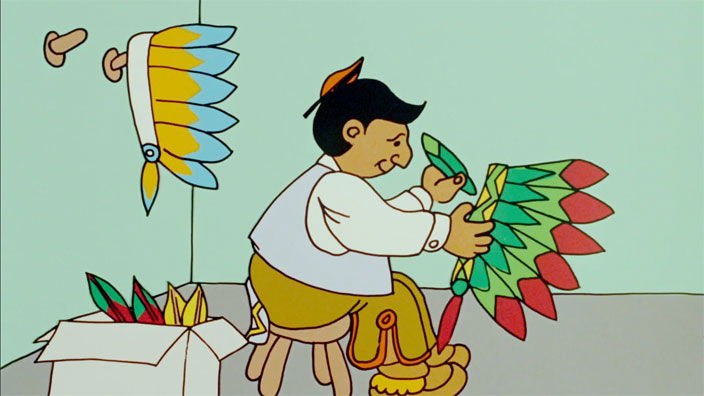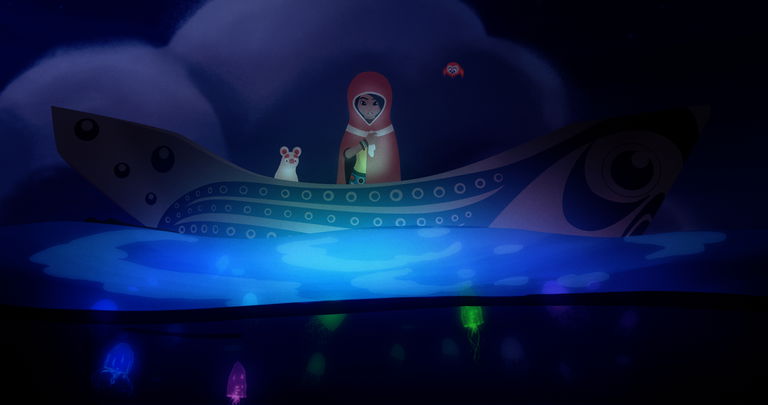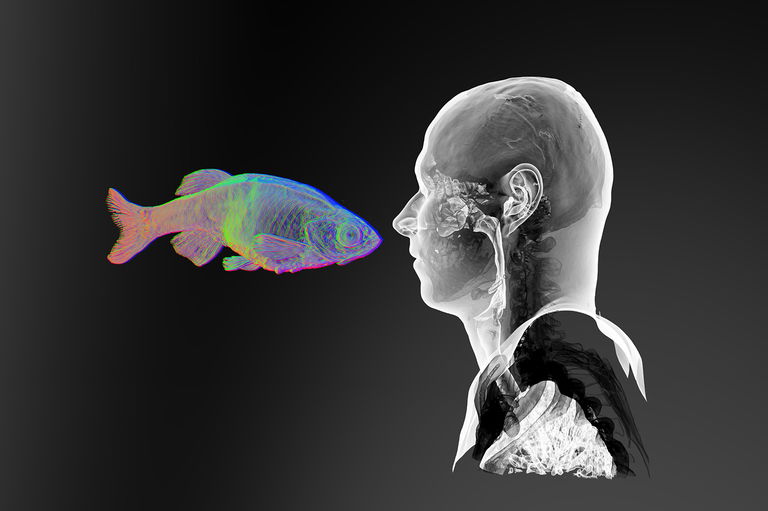
“People are Finally Listening”–Indigenous Animation Rises Up
Chris Robinson for Culture Days
Apr 14, 2020
The world of independent animation has never been perfect, but it’s always felt like a community that has generally been a step ahead of the rest of the artistic world. Operating primarily outside the animation industry, indie animation has long been a tolerant, inclusive community. That said, while there has been a pretty fair balance in Canadian animation in terms of gender, sexuality, and region, there has been, until recently, a notable lack of consistent Indigenous voices.

Not surprisingly, the National Film Board of Canada (NFB) has been behind the creation of a number of Indigenous created and inspired works. Duke Redbird’s 1969 short, Charlie Squash Goes to Town, was the first Indigenous animation produced at the NFB and possibly the first in Canada. In the 1970s and 1980s, a number of shorts told Inuit stories (e.g. The Owl and The Lemming, 1971; The Owl Who Married a Goose, 1973; Summer Legend, 1983). Unfortunately, they were all, albeit with good intentions, directed by non-Indigenous artists.
In 2006, the NFB, in collaboration with the Aboriginal People’s Television Network (APTN), co-produced the first two seasons of the pioneering stop motion series, Wapos Bay. Created by Dennis and Melanie Jackson, the series focused on life in a Cree community in Northern Saskatchewan. The show, which ran from 2006-2011, was aired in French, English, Cree and Inuk and had a positive influence on a number of Indigenous artists.
It was so powerful to see our stories on screen for the first time. I’ve great respect for the work that they put into the world and normalized it for us.
— Terril Calder, influential Métis artist and stop motion animator based in Toronto.
“Wapos Bay certainly did have a large influence on our early work and our company’s evolution,” says Neil Christopher, one of the co-founders of the Inuit owned, Nunavut-based studio, Taqqut Productions. “We started developing a stop motion series called Beyond the Inuksuk that never got picked up. This was our first big project and it was definitely inspired by Wapos Bay.”
In 2009, again in collaboration with APTN, the NFB produced the series, Vistas, a collection of 13 films created by Indigenous artists—including Diane Obomsawin, of Abenaki descent, who has since become a well-known and award-winning animator on the animation festival circuit—from across Canada.
In 2019, the NFB’s unique apprenticeship program, Hothouse—that gives emerging animators a chance to make a short film in 12 weeks—offered Indigenous creators from across the country an opportunity to create their own films. Chris Grant, a young Mi’kmaq artist from the Pabineau First Nation whose mother, Phyllis, made two NFB animated shorts (Maq and the Spirit of the Woods, 2006; Wasteg, 2008) was one of those participants.
“It was an experience of growth for me,” says Grant. “I was going through personal issues because I never lived in a cool city, had money and fun work. It was extremely important for me as an artist because it boosted my credentials I guess for more work. It made me realize I am an animator and filmmaker at heart, and always have been. It was a beautiful fractal of growth for me.”

Since about 2009 or 2010, Indigenous animation in Canada has also emerged outside the doors of the NFB, led by artists such as Terril Calder, Glenn Gear, Amanda Strong, Christopher Auchter and Taqqut Productions.
Taqqut Productions was founded in 2011 by Louise Flaherty and Neil Christopher. Their animation work, sometimes co-produced with the Montreal animation studio, e→d films, includes a mix of TV (Ananna’s Tent) and short films (e.g. Amaqqut Nunaat: The Country of Wolves, 2011; Little Folk of the Arctic, 2015; Giant Bear, 2018, What’s My Superpower, 2019) made primarily for younger audiences.
“The aim,” says Flaherty, “was to tell our stories using the language of the population of Nunavut. Taqqut’s part is to foremost tell stories coming from Inuit with authentic Inuit content, using the Inuit language. Inuktitut is being lost at 1% a year, and if we have animated films targeting children to retain the language, there must be more made.”
In recent years, the studio has branched out beyond traditional Inuit stories. “Our younger authors,” adds Flaherty, “are now leading Taqqut with their vision to create film catering to all audiences. We have created other animations not just from oral stories, but also stories from our books. Not just with animation, but also with puppets.”

In the realm of independent animation, Terril Calder has been an influential force since making her first stop motion films. Most of the work mentioned above has dealt with assorted myths/folk tales. Calder’s work is raw, unstable and haunting, tackling a number of personal and difficult issues like identity (Choke, 2010, co-created with Michelle Latimer; Canned Meat, 2009; Vessel, 2013), memory, isolation, and the unspeakable horrors of residential schools (Snip, 2016; Keewaydah, 2017).
A Drawing major graduate of the Fine Arts program at the University of Manitoba, Calder came to animation through Winnipeg’s Video Pool Media Arts Centre. “Animation,” says Calder, “held and holds so many possibilities to tell my stories and bring a different perspective to screen to make change. It really is the sum of all of my parts. Activism, Storytelling, Art, Painting, Sewing, Photography, Compositing…it completely challenges me in every way.”
After completing his MFA in sculpture/installation at Concordia, the Newfoundland born, Glenn Gear worked at a software development company in Montreal. “I became increasingly curious and inspired by traditional animation techniques. I fell in love with cardboard cutout and silhouette animation, but also looked at many other stop-motion animation processes with physical puppets. I began reading, researching, talking with other animators, and most importantly experimenting with as many techniques as I could with a small camera and basic setup. Although I didn’t have a formal education in animation, my background in photography and sculpture greatly helped me. The ability to create a whole world, brought to life frame-by-frame, was addictive and pure magic. I was hooked.”
Drawing on his Inuit and Newfoundland ancestry, Gear’s films touch upon personal and collective histories (e.g. Resettlement, Kablunât, Ikuma Siku), mixed with more poetic and playful stories (Rosewood Casket, Ginkgo, Cry of the Loup-garou) all with nature often in a central role.

Christopher Auchter grew up on the islands of Haida Gwaii, an archipelago off the Northern Pacific coast of Canada. He studied media at Vancouver’s Emily Carr University of Art and Design and later graduated from Sheridan College’s computer animation program. Auchter has worked in book illustration, animated for various TV series and video games, and has directed live action (Now is the Time, 2020) and animation shorts (notably the beautiful and award winning The Mountain of SGaana, 2017, which told an old Haida fable).
Michif artist Amanda Strong, whose animated shorts include the imaginative, haunting explorations of personal and collective ancestry, Four Faces of the Moon, 2016 and Biidaaban, 2017) came to stop motion animation through Photo and Illustration studies at Sheridan College. “It gave me a basis to explore moving-image while using these tools to create worlds and make stories move. Stop motion really is a series of photos that sequenced together create a magical experience of movement that can’t be replicated by software. It is beautiful to see that first shot move after years of making all the pieces and it sure is beautiful when the sonic and visual pieces unite. It’s a powerful tool to tell stories.”

There are a variety of reasons for this recent rise in Indigenous-created animation films, some of which overlap with the general rise in animation production. Advancements in technology have made animation a more accessible and affordable process for many. There was a time when animators were taking anywhere from 2 to 5 to 10 years to complete a short film. Today, there are a number of animators making films annually (sometimes more than one).
“The tools and processes to create animation are more accessible and cost less,” agrees Glenn Gear. “There have been great strides made in the past 10 years in terms of software, especially on alternative platforms such as smartphones. Apps like Stop Motion Studio, Animation Desk, and RoughAnimator are low cost and offer a streamlined workflow for animation. You don’t necessarily need a large studio with specialized equipment.”
Since the late 1990s, there has been a tsunami of animation programs and departments opening up across the world. To give the reader some context: I have been the Artistic Director of the Ottawa International Animation Festival (OIAF) since the early 1990s. When I first started with the OIAF in 1991, there were 750 films submitted to the then biannual festival. Today, the OIAF receives in the range of 2,400 films (including features, VR, TV, student etc.) annually.

The Simpsons (inspired by MTV and Sesame Street indirectly) showed producers and advertisers that animation could be profitable. This triggered an explosion in all avenues of animation and created a demand for talent. With the technological tools becoming more affordable, many educational institutions jumped on board to capitalize on the explosion—and to train and educate a new generation of animators.
Indigenous artists and youth have also benefited—alongside increasing public awareness of the unjust and sometimes horrific manner that Indigenous people have been treated in Canada—from these advancements. “There is more investment into teaching Indigenous youth and providing them with the digital tools alongside traditional knowledge and ways of working,” says Gear.
As more and more Indigenous folks migrate towards city centers, there are more informal and formal networks of knowledge, resource, and skill sharing. There is still much to be done in this regard, but the institutions such as universities, colleges and government institutions are slowly changing to hopefully be more accountable and transparent to Indigenous folks.
“We now have access to new tools and platforms,” adds Strong, whose Vancouver-based studio, Spotted Fawn Productions, creates space for Indigenous artists in animation. It excites me to see more and more Indigenous people of all ages engaging with tools and technology to animate their stories. It’s important that we lift each other up, celebrate our successes and always encourage other Indigenous storytellers to create.“
“Our voices, cultures, and diverse stories are finally being heard by a larger public,” adds Gear. “When I asked filmmaker Alanis Obomsawin about the changes she has seen in the reception of Indigenous work in the past 10 years, she said, ‘People are finally listening.’”
This article is part of a special blog series—running March-September—featuring writers and creatives from across Canada with stories that both highlight and celebrate Culture Days’ 2020 theme of Unexpected Intersections. Explore more intersections below:
- Theatre x Sport: Until the Lights Go Out by Taylor Basso
- Academia x Creativity: Building 21: Make zines, not research papers by Greta Rainbow
- Poetry x (Natural) Environment: Listen to the River: An Ode to the Columbia River by Saba Dar
- Teahouse x Activism: Chinatown’s Living Room: The gathering place for a budding activist community by Anto Chan
- Traditional Craftsmanship x Youth Outreach: At the Maritime Museum of the Atlantic, They Build More Than Boats by Aleen Leigh Stanton
- Visual Arts x Science: What happens when you mix an artist, a scientist and a very bright light? by Vivian Orr
- Book Clubs x Digital Landscapes: Strangers and Fiction by Anne Logan





